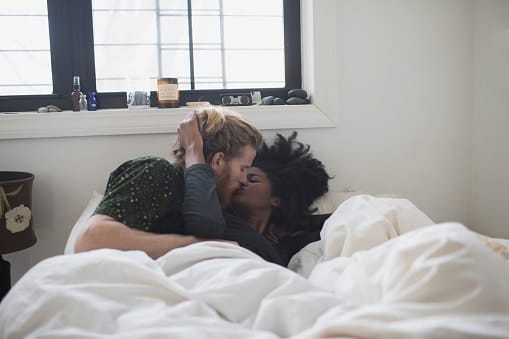How happy couples stay in sync—even when they’re stressed

Responding to each other with kindness is more important now than ever—here's how to do it.
Table of Contents
It was 8 pm on Sunday night and the kids were in bed. I was in the middle of urgent work emails for my mental health clinic to ensure we were prioritizing the health and care of our clients in light of the novel coronavirus spread. My work demanded my attention.
My partner walked into the room. I looked up and paused and saw the uncertainty in his eyes. I could see that he needed me.
This was one of those moments. This was a bid for attention.

Bids for attention are our attempts to connect with our partners—to be seen, to be appreciated, to be acknowledged, to be given affection
They can be small bids (like making eye contact and smiling) or bigger bids (like asking for help). Often it is not about what someone says or does, but rather the meaning behind the action.
When your partner asks, “How was work today?” (or even just, “What’s up?”) what they are really asking is, “Will you talk to me?”
If they glance over and smile at you, what they really want to know is, “Will you notice and connect with me?”
For some, reaching for connection with our partner takes the form of actual verbal requests for help, as in “I need help” or even “I feel like you don’t love me.”
Related: Guide your children with these 10 healthy marriage habits
For others, nonverbal expressions are how we attempt to connect—for affection, care and engagement.
On that Sunday night, my partner didn’t say anything. It was all in the look on his face.
I could have said “I have to do this!” and dismissed him from the room. I could have made a list of the things that were necessary to get done. I could have ignored him altogether.
But how we respond to these bids for attention in our relationships is key
We can either turn toward our partner and see these bids for attention, or we turn away and shut them down. Dr. John Gottman, the relationships researcher, clinical psychologist and founder of the Gottman Institute, found that couples who were still married six years after their initial research meeting turned towards each other 86% of the time, while couples who ended up divorced turned towards each other 33% of the time.
So how do we respond to bids for attention?
One way of responding is by turning toward your partner
This is you seeing your partner’s attempt to connect. This is you deciding that whatever is going on for you can wait because you can see that your partner needs you. This is you, at times, putting aside your own feelings, and seeing your partner’s.
What does turning toward look like?
- Smiling back and holding eye contact.
- Sharing the feeling that comes up at that moment.
- Responding to touch and letting your partner know you feel them there and appreciate their efforts to connect.
- Asking what your partner needs in the moment.
- Seeing your partner’s emotion and reflecting it back to them.
- Asking how you can help them in this moment.
- Asking a following up question.
The challenge, of course, is that during times of stress and overwhelm, or when we feel disconnected and distressed, we get stuck in turning away from our partners.
Related: To my husband: When motherhood gets tough, you make it easier
Turning away takes a number of forms, too
Sometimes it looks like walking away and not acknowledging your partner, or passing each other in the hall and not meeting your partner’s gaze. It may also look like staying away from your partner instead of going to them, or changing the topic when difficult things are brought up. It may also be minimizing the other person’s experience (“it’s not a big deal”) or coming back with a defensive response. Maybe you don’t even respond to your partner at all.
Missing these bids for attention sends our partner the message that we don’t see them and that they are not important. This slowly erodes the health of your relationship.
We all miss bids for attention at times—particularly during times of stress and struggle. We must learn to tune into our partner and see them when they are asking—silently or out loud—for connection. What are the ways your partner tries for your attention? Have you shared with your partner how you try to get their attention?
On that Sunday night, in the middle of a pandemic, I chose connection. I paused my work and connected with him. I asked him what was going on for him, and I held him close.
You can choose to respond to your partner during this difficult time. You can choose to see your partner in front of you and create closeness and responsiveness. Because this is a time when we all need to create connections.


































